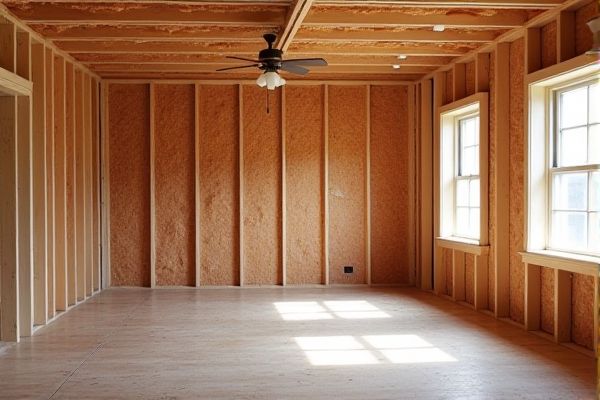
Noise insulation reduces sound transmission between spaces by using materials that absorb or block sound waves, while thermal insulation minimizes heat transfer to maintain temperature control in buildings. Understanding the differences between these two types of insulation can help you choose the best solution for your comfort and energy efficiency needs; continue reading to explore their specific applications and benefits.
Table of Comparison
| Feature | Noise Insulation | Thermal Insulation |
|---|---|---|
| Purpose | Reduces sound transmission and noise pollution | Minimizes heat transfer and maintains temperature |
| Materials | Acoustic foam, mineral wool, dense fiberglass | Fiberglass, foam board, cellulose, reflective barriers |
| Key Properties | Sound absorption, density, damping | R-value, thermal resistance, conductivity |
| Applications | Walls, floors, ceilings, studios, offices | Walls, roofs, attics, HVAC systems |
| Effectiveness Measurement | STC (Sound Transmission Class) | R-value (Thermal Resistance) |
| Benefits | Enhances acoustic comfort, reduces noise pollution | Improves energy efficiency, reduces heating/cooling costs |
| Installation Considerations | Requires airtight sealing and layering for best results | Needs continuous coverage, moisture control |
Understanding Noise Insulation
Noise insulation reduces sound transmission by using dense materials like mass-loaded vinyl or acoustic foam, effectively blocking airborne and impact noises in your space. Thermal insulation focuses on materials such as fiberglass or foam board that minimize heat transfer, maintaining indoor temperature and energy efficiency. Understanding noise insulation helps you choose the right solution for soundproofing by targeting sound waves and vibrations rather than just temperature control.
What is Thermal Insulation?
Thermal insulation refers to materials or methods used to reduce heat transfer between objects or environments with different temperatures, enhancing energy efficiency in buildings. Common thermal insulation materials include fiberglass, foam boards, and reflective barriers, which minimize heat loss in winter and heat gain in summer. Effective thermal insulation improves indoor comfort, lowers heating and cooling costs, and reduces environmental impact by maintaining stable indoor temperatures.
Key Differences Between Noise and Thermal Insulation
Noise insulation primarily targets sound attenuation by using dense, porous, or resilient materials like mineral wool or acoustic foam to block or absorb sound waves. Thermal insulation focuses on reducing heat transfer through materials such as fiberglass, foam board, or reflective barriers to maintain temperature control. Your choice depends on whether controlling ambient noise or improving energy efficiency is the priority, as these insulations serve distinct but sometimes complementary purposes.
How Noise Insulation Works
Noise insulation works by reducing sound transmission through materials that absorb, dampen, or block sound waves, such as dense insulation boards, acoustic panels, or specialized foam. High-performance soundproofing materials often feature porous structures that trap air and dissipate sound energy, preventing it from passing through walls, ceilings, or floors. Effective noise insulation involves layering different materials to target various frequencies, enhancing overall acoustic comfort and minimizing external or internal noise disturbances.
How Thermal Insulation Functions
Thermal insulation functions by reducing heat transfer between spaces through materials with low thermal conductivity, trapping air or gas within their structure to minimize heat flow. Unlike noise insulation, which targets sound wave absorption or reflection to reduce noise pollution, thermal insulation primarily aims to maintain desired indoor temperatures, enhancing energy efficiency and comfort. Your home's insulation can significantly impact heating and cooling costs by preventing heat loss in winter and heat gain in summer.
Common Materials for Noise Insulation
Common materials for noise insulation include mineral wool, fiberglass, and acoustic foam, which effectively absorb sound waves and reduce noise transmission. Dense materials like mass-loaded vinyl and soundproof drywall are also popular for their ability to block sound rather than just absorb it. Your choice of material depends on the specific noise reduction needs and the environment where insulation is applied.
Common Materials for Thermal Insulation
Common materials for thermal insulation include fiberglass, mineral wool, foam board, and cellulose, each known for its ability to reduce heat transfer in buildings. Fiberglass insulation, made from fine glass fibers, offers excellent R-values and fire resistance, while foam boards such as polystyrene and polyurethane provide high thermal resistance in a rigid format. Cellulose insulation, composed of recycled paper treated with fire retardants, is valued for its eco-friendliness and effective air sealing properties.
Application Areas: Noise vs Thermal Insulation
Noise insulation is commonly applied in residential buildings, recording studios, and industrial plants to reduce sound transmission and enhance acoustic comfort. Thermal insulation is primarily used in building envelopes, HVAC systems, and refrigeration units to regulate temperature and improve energy efficiency. While noise insulation targets soundproofing in living and working spaces, thermal insulation focuses on maintaining temperature stability in structures and appliances.
Factors to Consider When Choosing Insulation
Choosing insulation requires assessing factors such as material density, thickness, and thermal resistance (R-value), which influence both noise and thermal insulation effectiveness. Acoustic insulation focuses on materials like mineral wool or fiberglass that absorb sound waves, while thermal insulation prioritizes materials with low thermal conductivity to reduce heat transfer. Climate, building structure, and intended use should guide the balance between soundproofing and energy efficiency needs.
Cost and Long-Term Benefits Comparison
Noise insulation materials such as mineral wool and acoustic foam often come at a moderate initial cost but provide substantial long-term benefits by reducing noise pollution and improving indoor comfort. Thermal insulation, including fiberglass and spray foam, tends to have higher upfront expenses but delivers significant energy savings over time by enhancing heating and cooling efficiency. Investing in thermal insulation generally results in greater long-term financial returns due to lower utility bills, while noise insulation benefits are more focused on improved living quality rather than direct monetary savings.
 homyna.com
homyna.com